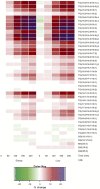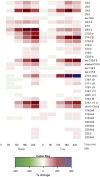Postprandial lipemic response in dairy-avoiding females following an equal volume of sheep milk relative to cow milk: A randomized controlled trial
- PMID: 36687710
- PMCID: PMC9846784
- DOI: 10.3389/fnut.2022.1029813
Postprandial lipemic response in dairy-avoiding females following an equal volume of sheep milk relative to cow milk: A randomized controlled trial
Abstract
Background: Sheep milk (SM) is an alternate dairy source, which despite many similarities, has both compositional and structural differences in lipids compared to cow milk (CM). Studies are yet to examine the apparent digestibility of SM lipids, relative to CM, and the potential impact on the plasma lipidome.
Objective: To determine the response of the circulatory lipidome to equal volume servings of SM and CM, in females who avoid dairy products.
Method: In a double-blinded, randomized, cross-over trial, self-described dairy avoiding females (n = 30; 24.4 ± 1.1 years) drank SM or CM (650 mL; 33.4 vs. 21.3 g total lipid content; reconstituted from spray dried milk powders) following an overnight fast. Blood samples were collected at fasting and at regular intervals over 4 h after milk consumption. The plasma lipidome was analyzed by LC-MS and fatty acids were quantified by GC-FID.
Results: The overall postprandial triglyceride (TG) response was similar between SM and CM. TG concentrations were comparable at fasting for both groups, however they were higher after CM consumption at 30 min (interaction milk × time p = 0.003), well before any postprandial lipemic response. This was despite greater quantities provided by SM. However, there were notable differences in the postprandial fatty acid response, with SM leading to an increase in short- and medium-chain fatty acids (MCFAs) (C6:0, C8:0, and C10:0) and several long-chain fatty acids (LCFAs) (C18:1 t11, c9, t11-CLA, and C20:0; interaction time × milk p < 0.05). This corresponded to a greater postprandial response for medium chain triglycerides (MCTs) C10:0, including TG(10:0/14:0/18:1), TG(16:0/10:0/12:0), and TG(16:0/10:0/14:0) (interaction time × milk p < 0.05).
Conclusions: Despite a higher fat content, SM ingestion resulted in a greater circulating abundance of MCTs, without increasing total postprandial triglyceride response, when compared to CM. The greater abundance and postprandial appearance of MCTs may provide advantageous metabolic responses in children and adults.
Unique identifier and registry: U1111-1209-7768; https://www.anzctr.org.au/Trial/Registration/TrialReview.aspx?id=375324.
Keywords: adult nutrition; bovine milk; fatty acids; lipid digestion; lipidomics; milk alternative; ovine milk; postprandial lipemia.
Copyright © 2023 Teng, Samuelsson, Milan, Subbaraj, Agnew, Shrestha, Cameron-Smith and Day.
Conflict of interest statement
FT, LS, AM, MA, and LD were employed by AgResearch Ltd., Grasslands Research Center, Palmerston North, New Zealand. AS is employed by AgResearch Ltd., Lincoln Research Center, Lincoln, New Zealand. The remaining authors declare that the research was conducted in the absence of any commercial or financial relationships that could be construed as a potential conflict of interest.
Figures




Similar articles
-
Circulating Branched Chain Amino Acid Concentrations Are Higher in Dairy-Avoiding Females Following an Equal Volume of Sheep Milk Relative to Cow Milk: A Randomized Controlled Trial.Front Nutr. 2020 Nov 5;7:553674. doi: 10.3389/fnut.2020.553674. eCollection 2020. Front Nutr. 2020. PMID: 33240914 Free PMC article.
-
Comparing Response of Sheep and Cow Milk on Acute Digestive Comfort and Lactose Malabsorption: A Randomized Controlled Trial in Female Dairy Avoiders.Front Nutr. 2021 Feb 15;8:603816. doi: 10.3389/fnut.2021.603816. eCollection 2021. Front Nutr. 2021. PMID: 33659266 Free PMC article.
-
Medium-chain fatty acids lower postprandial lipemia: A randomized crossover trial.Clin Nutr. 2020 Jan;39(1):90-96. doi: 10.1016/j.clnu.2019.02.008. Epub 2019 Feb 16. Clin Nutr. 2020. PMID: 30824268 Clinical Trial.
-
Heat Treatment of Milk: A Rapid Review of the Impacts on Postprandial Protein and Lipid Kinetics in Human Adults.Front Nutr. 2021 Apr 30;8:643350. doi: 10.3389/fnut.2021.643350. eCollection 2021. Front Nutr. 2021. PMID: 33996872 Free PMC article.
-
Long-chain n-3 polyunsaturated fatty acids and triacylglycerol metabolism in the postprandial state.Lipids. 1999;34 Suppl:S259-65. doi: 10.1007/BF02562313. Lipids. 1999. PMID: 10419173 Review.
Cited by
-
Study Protocol for a Randomized Controlled Trial Investigating the Effects of the Daily Consumption of Ruminant Milk on Digestive Comfort and Nutrition in Older Women: The YUMMI Study.Nutrients. 2024 Dec 6;16(23):4215. doi: 10.3390/nu16234215. Nutrients. 2024. PMID: 39683608 Free PMC article.
References
-
- Rosensweig NS. Adult human milk intolerance and intestinal lactase deficiency. A review. J Dairy Sci. (1969) 52:585–7. - PubMed
LinkOut - more resources
Full Text Sources
Research Materials
Miscellaneous

